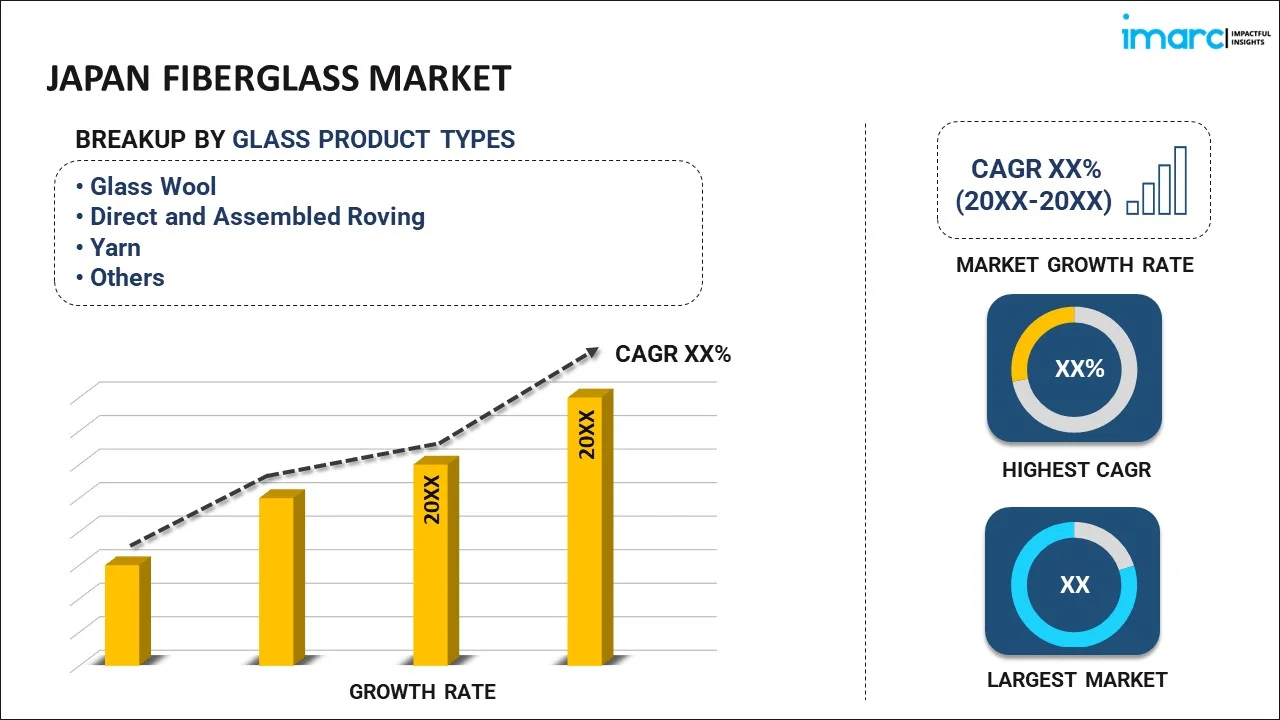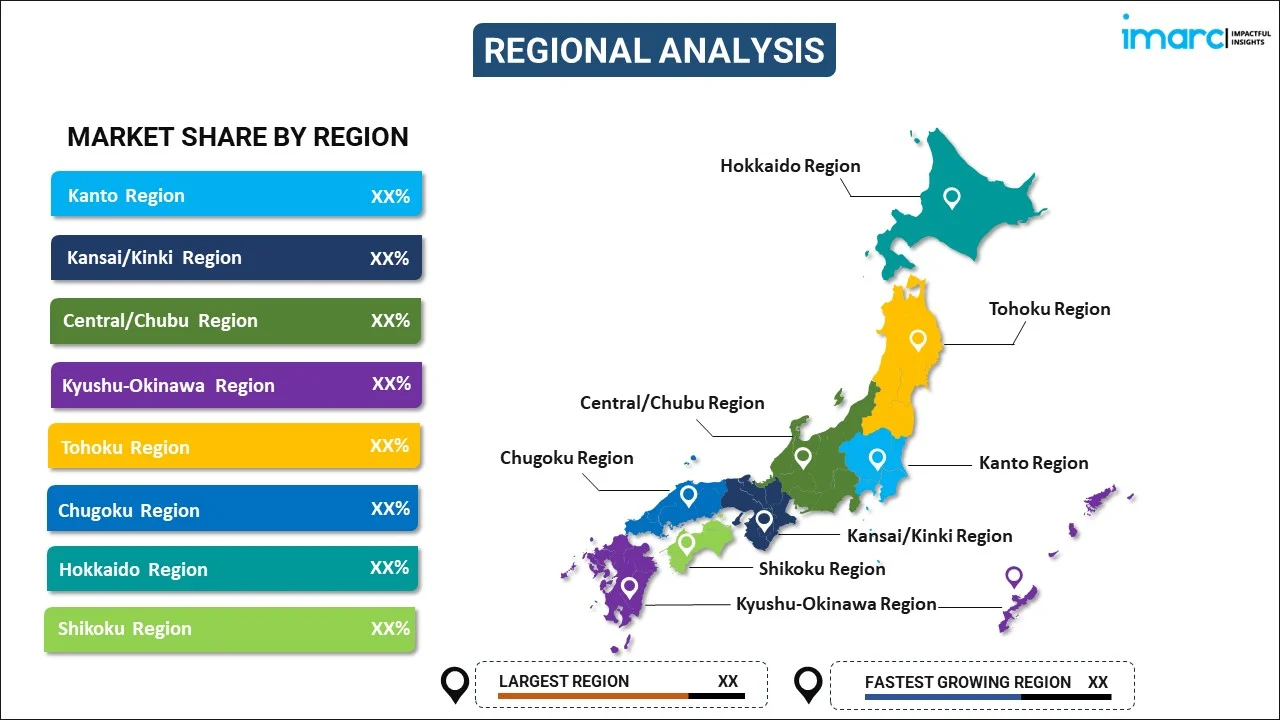
Japan Fiberglass Market Report by Glass Product Type (Glass Wool, Direct and Assembled Roving, Yarn, Chopped Strand, and Others), Glass Fiber Type (E-Glass, A-Glass, S-Glass, AR-Glass, C-Glass, R-Glass, and Others), Resin Type (Thermoset Resin, Thermoplastic Resin), Application (Composites, Insulation), End User (Construction, Automotive, Wind Energy, Aerospace and Defense, Electronics, and Others), and Region 2025-2033
Market Overview:
Japan fiberglass market size reached USD 757.0 Million in 2024. Looking forward, IMARC Group expects the market to reach USD 1,332.0 Million by 2033, exhibiting a growth rate (CAGR) of 6.5% during 2025-2033. The expanding automotive industry, the presence of a robust shipbuilding sector in the country, a significant rise in construction projects, and ongoing technological advancements in material science represent some of the key factors driving the market.
|
Report Attribute
|
Key Statistics
|
|---|---|
|
Base Year
|
2024
|
|
Forecast Years
|
2025-2033
|
|
Historical Years
|
2019-2024
|
|
Market Size in 2024
|
USD 757.0 Million |
|
Market Forecast in 2033
|
USD 1,332.0 Million |
| Market Growth Rate 2025-2033 | 6.5% |
Fiberglass is a composite material made from fine fibers of glass woven into a fabric and reinforced with a resin binder. It is a popular substitute for materials like wood, steel, and aluminum and offers distinct advantages. It possesses high tensile strength, making it incredibly durable yet lightweight. It is also highly resistant to corrosion, which makes it ideal for use in harsh environments. The production process involves melting glass and drawing it into thin strands, thinner than human hair. These strands are then bundled together to form roving, which can be woven into mats or cloth. When combined with plastic resins, usually epoxy or polyester, the resulting material can be molded into a wide array of shapes and sizes. Commonly found in applications like boat building, automobile parts, and construction, fiberglass is also utilized in the manufacturing of products like bathtubs, water tanks, and pipes. The material is especially valuable in industries seeking a balance between strength and weight, such as the aerospace and automotive sectors. It also provides excellent thermal insulation and electrical insulation capabilities. As a result, fiberglass has gained immense traction as a versatile, cost-effective, and durable solution for multiple industrial applications across Japan and the world.
Japan Fiberglass Market Trends:
The Japan fiberglass market is currently experiencing growth fueled by a range of factors. Primarily, the automotive industry in Japan, known for its innovation and high-quality products, is increasingly adopting fiberglass as a material for parts owing to its superior strength-to-weight ratio, thus driving market growth. This shift aims to make vehicles lighter and more fuel-efficient, aligning with global trends focusing on energy efficiency and emission reduction. Moreover, the country’s extensive shipbuilding industry, which utilizes fiberglass in the construction of boats and other marine vehicles due to its resilience to water and corrosive elements, is further contributing to the market growth. Given Japan’s long coastline and its historical reliance on marine transport, this is an area where fiberglass application is witnessing a steady rise. Additionally, the construction sector across the country is witnessing a revival, with numerous infrastructure projects in the pipeline. Japan’s vulnerability to natural disasters like earthquakes and tsunamis catalyzes the demand for materials like fiberglass that are both strong and flexible. This makes it an ideal choice for constructing buildings and bridges capable of withstanding such conditions. Furthermore, ongoing technological advancements in material science and innovations in fiberglass composites, such as the development of high-performance resins, are broadening the scope of product applications. Industries like aerospace and electronics, where Japan already has a significant presence, are increasingly exploring the use of fiberglass in components that require high strength and thermal resistance. In line with this, Japan’s commitment to sustainable development is propelling the demand for renewable energy infrastructure, such as wind turbines. Fiberglass is a critical material in the blades of these turbines, which must be both strong and lightweight to function effectively, thereby supporting market growth.
Japan Fiberglass Market Segmentation:
IMARC Group provides an analysis of the key trends in each segment of the market, along with forecasts at the country level for 2025-2033. Our report has categorized the market based on glass product type, glass fiber type, resin type, application, and end user.
Glass Product Type Insights:

- Glass Wool
- Direct and Assembled Roving
- Yarn
- Chopped Strand
- Others
The report has provided a detailed breakup and analysis of the market based on the glass product type. This includes glass wool, direct and assembled roving, yarn, chopped strand, and others.
Glass Fiber Type Insights:
- E-Glass
- A-Glass
- S-Glass
- AR-Glass
- C-Glass
- R-Glass
- Others
A detailed breakup and analysis of the market based on the glass fiber type have also been provided in the report. This includes E-glass, A-glass, S-glass, AR-glass, C-glass, R-glass, and others.
Resin Type Insights:
- Thermoset Resin
- Thermoplastic Resin
The report has provided a detailed breakup and analysis of the market based on the resin type. This includes thermoset resin and thermoplastic resin.
Application Insights:
- Composites
- Insulation
A detailed breakup and analysis of the market based on the application have also been provided in the report. This includes composites and insulation.
End User Insights:
- Construction
- Automotive
- Wind Energy
- Aerospace and Defense
- Electronics
- Others
The report has provided a detailed breakup and analysis of the market based on the End user. This includes construction, automotive, wind energy, aerospace and defense, electronics, and others.
Regional Insights:

- Kanto Region
- Kansai/Kinki Region
- Central/ Chubu Region
- Kyushu-Okinawa Region
- Tohoku Region
- Chugoku Region
- Hokkaido Region
- Shikoku Region
The report has also provided a comprehensive analysis of all the major regional markets, which include Kanto Region, Kansai/Kinki Region, Central/ Chubu Region, Kyushu-Okinawa Region, Tohoku Region, Chugoku Region, Hokkaido Region, and Shikoku Region.
Competitive Landscape:
The market research report has also provided a comprehensive analysis of the competitive landscape. Competitive analysis such as market structure, key player positioning, top winning strategies, competitive dashboard, and company evaluation quadrant has been covered in the report. Also, detailed profiles of all major companies have been provided.
Japan Fiberglass Market Report Coverage:
| Report Features | Details |
|---|---|
| Base Year of the Analysis | 2024 |
| Historical Period | 2019-2024 |
| Forecast Period | 2025-2033 |
| Units | Million USD |
| Scope of the Report | Exploration of Historical and Forecast Trends, Industry Catalysts and Challenges, Segment-Wise Historical and Predictive Market Assessment:
|
| Glass Product Types Covered | Glass Wool, Direct and Assembled Roving, Yarn, Chopped Strand, Others |
| Glass Fiber Types Covered | E-Glass, A-Glass, S-Glass, AR-Glass, C-Glass, R-Glass, Others |
| Resin Types Covered | Thermoset Resin, Thermoplastic Resin |
| Applications Covered | Composites, Insulation |
| End Users Covered | Construction, Automotive, Wind Energy, Aerospace and Defense, Electronics, Others |
| Regions Covered | Kanto Region, Kansai/Kinki Region, Central/ Chubu Region, Kyushu-Okinawa Region, Tohoku Region, Chugoku Region, Hokkaido Region, Shikoku Region |
| Customization Scope | 10% Free Customization |
| Post-Sale Analyst Support | 10-12 Weeks |
| Delivery Format | PDF and Excel through Email (We can also provide the editable version of the report in PPT/Word format on special request) |
Key Questions Answered in This Report:
- How has the Japan fiberglass market performed so far and how will it perform in the coming years?
- What has been the impact of COVID-19 on the Japan fiberglass market?
- What is the breakup of the Japan fiberglass market on the basis of glass product type?
- What is the breakup of the Japan fiberglass market on the basis of glass fiber type?
- What is the breakup of the Japan fiberglass market on the basis of resin type?
- What is the breakup of the Japan fiberglass market on the basis of application?
- What is the breakup of the Japan fiberglass market on the basis of end user?
- What are the various stages in the value chain of the Japan fiberglass market?
- What are the key driving factors and challenges in the Japan fiberglass?
- What is the structure of the Japan fiberglass market and who are the key players?
- What is the degree of competition in the Japan fiberglass market?
Key Benefits for Stakeholders:
- IMARC’s industry report offers a comprehensive quantitative analysis of various market segments, historical and current market trends, market forecasts, and dynamics of the Japan fiberglass market from 2019-2033.
- The research report provides the latest information on the market drivers, challenges, and opportunities in the Japan fiberglass market.
- Porter's five forces analysis assist stakeholders in assessing the impact of new entrants, competitive rivalry, supplier power, buyer power, and the threat of substitution. It helps stakeholders to analyze the level of competition within the Japan fiberglass industry and its attractiveness.
- Competitive landscape allows stakeholders to understand their competitive environment and provides an insight into the current positions of key players in the market.
Need more help?
- Speak to our experienced analysts for insights on the current market scenarios.
- Include additional segments and countries to customize the report as per your requirement.
- Gain an unparalleled competitive advantage in your domain by understanding how to utilize the report and positively impacting your operations and revenue.
- For further assistance, please connect with our analysts.
 Inquire Before Buying
Inquire Before Buying
 Speak to an Analyst
Speak to an Analyst
 Request Brochure
Request Brochure
 Request Customization
Request Customization




.webp)




.webp)












